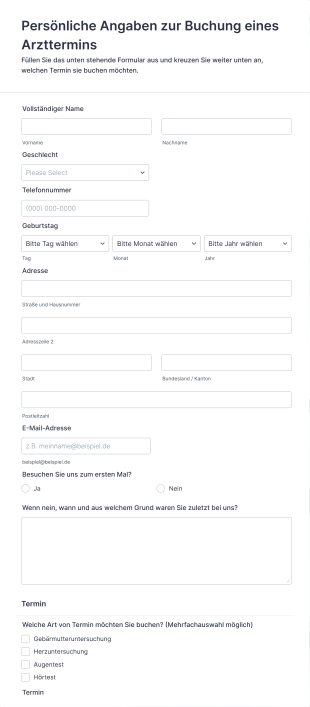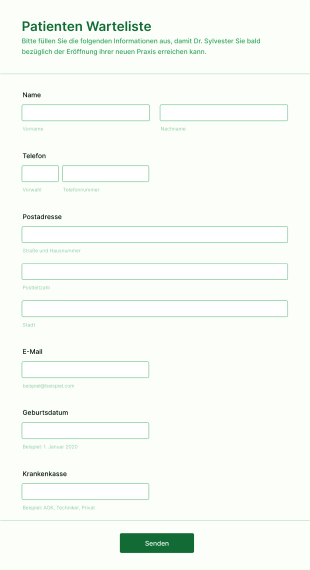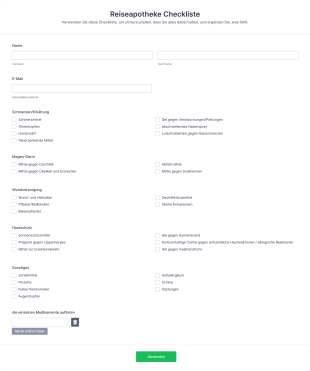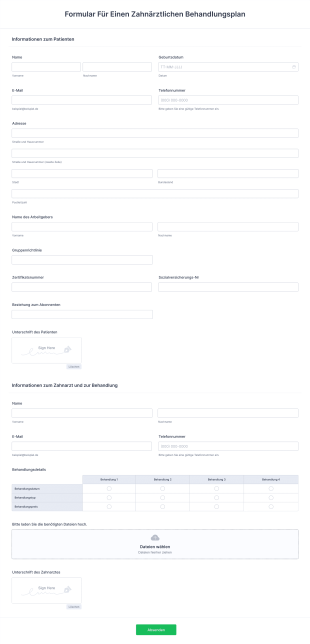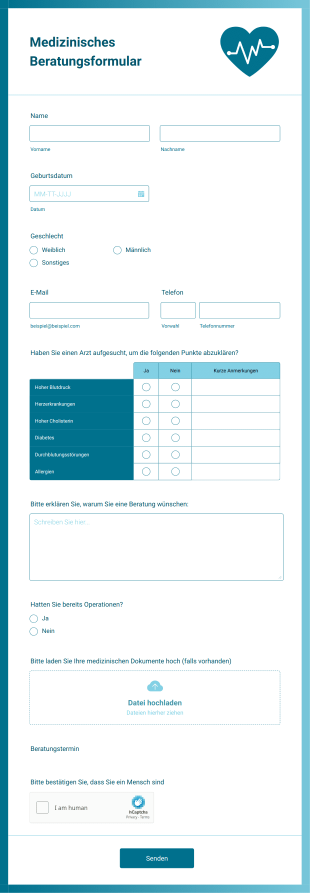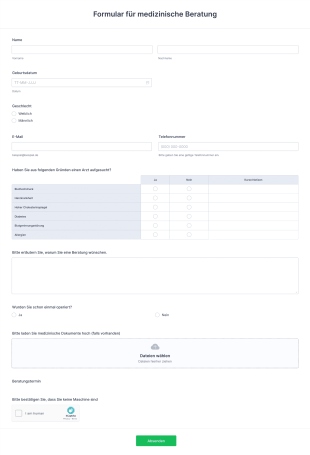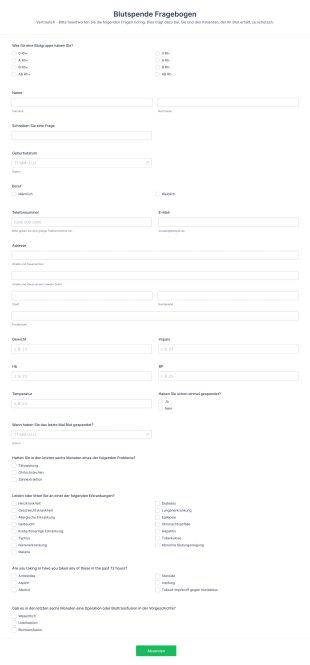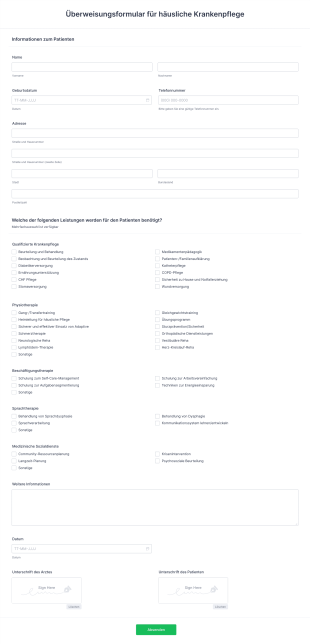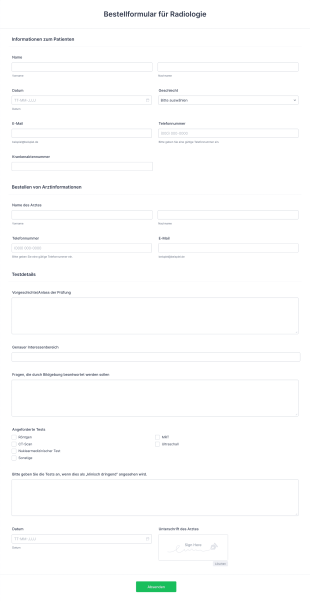Medizinische Antragsformulare
Über Medizinische Antragsformulare
Medizinische Antragsformulare sind wichtige Instrumente, die von Gesundheitsdienstleistern, Kliniken, Krankenhäusern und medizinischen Einrichtungen verwendet werden, um wichtige Informationen von Patienten, Mitarbeitern oder Bewerbern zu erfassen. Diese Formulare optimieren den Aufnahmeprozess für neue Patienten, erleichtern Stellenbewerbungen für medizinisches Personal, verwalten die Anmeldung von Ehrenamtlichen und unterstützen verschiedene administrative Aufgaben im Gesundheitswesen. Medizinische Antragsformulare können für Patientenregistrierungen, Terminanfragen, Versicherungsüberprüfungen, die Erfassung der Krankengeschichte, Mitarbeiter-Onboarding und mehr verwendet werden. Durch die Standardisierung der Informationserfassung tragen diese Formulare zu Genauigkeit, Compliance und Effizienz in medizinischen Arbeitsabläufen bei.
Mit Jotform wird das Erstellen und Verwalten von medizinischen Antragsformularen mühelos und individuell anpassbar. Mit dem No-Code Formulargenerator von Jotform können Benutzer Formulare erstellen, die auf ihre spezifischen Bedürfnisse zugeschnitten sind – sei es für die Patientenaufnahme, Personalrekrutierung oder Ehrenamtsbewerbungen. Die Drag-and-Drop-Oberfläche in Kombination mit einer umfangreichen Bibliothek an Vorlagen und Integrationen ermöglicht es medizinischem Fachpersonal, schnell sichere, HIPAA-gerechte Formulare zu erstellen. Einsendungen werden automatisch organisiert und gespeichert, wodurch der Zugriff, die Überprüfung und die Verwaltung von Daten einfach wird. Die erweiterten Funktionen von Jotform wie bedingte Logik, Zahlungsintegrationen und automatische Benachrichtigungen steigern zusätzlich die Effizienz und Zuverlässigkeit medizinischer Antragsprozesse.
Anwendungsbeispiele von medizinischen Antragsformularen
Medizinische Antragsformulare erfüllen in Einrichtungen des Gesundheitswesens vielfältige Zwecke und dienen verschiedenen administrativen und klinischen Anforderungen. Dank ihrer Vielseitigkeit können unterschiedliche User spezifische Probleme effizient lösen. Hier erfahren Sie, wie sie eingesetzt werden können:
- Patientenregistrierung: Optimiert den Aufnahmeprozess durch die Erfassung persönlicher Daten, Patientenakten, Versicherungsdaten und Einverständniserklärungen vor Terminen.
- Bewerbungen von Mitarbeitern und Ärzten: Ermöglicht Krankenhäusern und Kliniken, Qualifikationen, Berufserfahrung, Zertifizierungen und Referenzen von Bewerbern in einem standardisierten Format zu erfassen.
- Bewerbungen für Freiwillige: Unterstützung von Organisationen bei der Rekrutierung von Freiwilligen durch das Sammeln von Hintergrundinformationen, Verfügbarkeiten und relevanten Erfahrungen.
- Anmeldungen für Sonderprogramme: Dienen zur Anmeldung von Patienten für klinische Studien, Gesundheitsprogramme oder Impfkampagnen und zur Erfassung der Teilnahmeberechtigung und Einwilligung.
- Versicherungs- und Abrechnungsanwendungen: Erleichtert die Erfassung von Versicherungsdaten und Rechnungsinformationen, um eine reibungslose Bearbeitung von Leistungsansprüchen zu gewährleisten.
Lösungsansätze:
- Weniger Papierkram und manuelle Dateneingabefehler.
- Gewährleistet die Einhaltung von Vorschriften im Gesundheitswesen.
- Verbessert die Datengenauigkeit und Zugänglichkeit.
- Verbessert die Erfahrung von Patienten und Personal durch Minimierung der Wartezeiten.
Mögliche Eigentümer und Nutzer:
- Krankenhäuser, Kliniken und Privatpraxen.
- Personalabteilungen in Gesundheitsorganisationen.
- Gemeinnützige Organisationen und kommunale Gesundheitsprogramme.
- Medizinische Forschungseinrichtungen.
Unterschiede der Erstellungsmethoden:
- Patientenformulare: Konzentrieren sich auf persönliche, medizinische und Versicherungsdaten, die häufig E-Signaturen und Einverständnis-Checkboxen erfordern.
- Mitarbeiterbewerbungen: Legen Sie Wert auf berufliche Qualifikationen, Lizenzen und Referenzen.
- Formulare für Freiwillige: Erfassen Sie die Verfügbarkeit, Background-Checks und Notfallkontaktdaten.
- Programmanmeldungen: Erfordern Screening-Fragen zur Teilnahmeberechtigung und spezifische Einwilligungsfelder.
Zusammenfassend lässt sich sagen, dass medizinische Antragsformulare an eine Vielzahl von Szenarien im Gesundheitswesen angepasst werden können, sodass jeder Use Case die erforderlichen Informationen effizient und sicher erfasst.
So erstellen Sie ein medizinisches Antragsformular
Das Erstellen eines medizinischen Antragsformulars mit Jotform ist ein unkomplizierter Vorgang, der an jedes Szenario im Gesundheitswesen angepasst werden kann, von der Patientenaufnahme bis zur Personalrekrutierung. Die folgende Schritt-für-Schritt-Anleitung hilft Ihnen dabei, ein effektives Formular zu gestalten, das Ihren spezifischen Anforderungen entspricht:
1. Definieren Sie Ihren Use Case und Anforderungen:
- Bestimmen Sie den Zweck Ihres Formulars (z. B. Patientenregistrierung, Mitarbeiterbewerbung, Anmeldung von Freiwilligen Helfern).
- Listen Sie die Informationen auf, die Sie erfassen müssen, z. B. persönliche Angaben, Patientenakte, Versicherungsdaten oder berufliche Qualifikationen.
2. Beginnen Sie mit der Erstellung Ihres Formulars:
- Melden Sie sich bei Ihrem Jotform-Konto an und klicken Sie auf Ihrer Seite „Mein Workspace" auf „Erstellen".
- Wählen Sie „Formular“ und entscheiden Sie, ob Sie ganz neu beginnen oder eine der über 10.000 medizinischen Formularvorlagen von Jotform verwenden möchten.
- Wählen Sie ein Layout: Klassisches Formular (alle Fragen auf einer Seite) für umfangreiche Anwendungen oder Kartenformular (eine Frage pro Seite) für eine geführte Erfahrung.
3. Formularelemente hinzufügen und anpassen:
Verwenden Sie das Menü „Element hinzufügen“, um wichtige Felder per Drag & Drop zu bearbeiten:
- Grundlegende Felder: Name, Kontaktdaten, Geburtsdatum, Adresse.
- Medizinische Bereiche: Patientenakte, Allergien, aktuelle Medikamente, Versicherungsdaten.
- Berufliche Qualifikationen (für Mitarbeiter): Ausbildung, Zertifizierungen, Berufserfahrung, Referenzen.
- Einwilligung und Unterschriften: E-Signaturfelder, Einwilligungs-Checkboxen, HIPAA-Compliance-Erklärungen.
- Datei-Uploads: Für Lebensläufe, Lizenzen oder medizinische Dokumente.
- Wenden Sie bedingte Logik an, um Felder basierend auf den Antworten der Benutzer anzuzeigen oder auszublenden (z. B. Versicherungsfelder nur anzeigen, wenn der Antragsteller versichert ist).
4. Gestalten und kennzeichnen Sie Ihr Formular:
- Klicken Sie auf das Symbol Farbroller, um den Formulardesigner zu öffnen.
- Passen Sie Farben, Schriftarten und Layout an das Branding Ihrer Organisation an.
- Fügen Sie das Logo Ihrer Organisation hinzu und aktualisieren Sie den Formulartitel für mehr Klarheit.
5. Benachrichtigungen und Automatisierungen einrichten:
- Konfigurieren Sie im Einstellungsmenü E-Mail-Benachrichtigungen für Ihr Team und automatische Antworten für Bewerber.
- Mit anderen Tools integrieren (z. B. Google Tabellen, CRM oder EHR-Systeme) für nahtloses Datenmanagement.
6. Veröffentlichen und teilen Sie Ihr Formular:
- Klicken Sie auf „Veröffentlichen“, um einen Link zum Teilen zu generieren oder das Formular auf Ihrer Website einzubetten.
- Verteilen Sie das Formular nach Bedarf per E-Mail, Social Media oder QR-Codes.
7. Einreichungen testen und verwalten:
- Nutzen Sie die Vorschau, um Ihr Formular zu testen und sicherzustellen, dass alle Felder korrekt funktionieren.
- Überwachen Sie Antworten in Jotform Tabellen, wo Sie Daten sicher filtern, durchsuchen und exportieren können.
Mit diesen Schritten können Sie ein medizinisches Bewerbungsformular erstellen, das die Datenerfassung optimiert, die Genauigkeit erhöht und die allgemeine Erfahrung sowohl für Bewerber als auch für Ihr Verwaltungsteam verbessert.
Häufig gestellte Fragen
1. Was ist ein medizinisches Antragsformular?
Ein medizinisches Antragsformular ist ein digitales oder gedrucktes Dokument, das von Gesundheitsorganisationen verwendet wird, um wichtige Informationen von Patienten, Mitarbeitern oder Freiwilligen für administrative oder klinische Zwecke zu erfassen.
2. Warum sind medizinische Antragsformulare im Gesundheitswesen wichtig?
Sie helfen dabei, die Datenerfassung zu standardisieren, Fehler zu reduzieren, die Einhaltung von Vorschriften sicherzustellen und Prozesse wie Patientenaufnahme, Personaleinstellung und Programmanmeldung zu optimieren.
3. Welche Informationen werden in der Regel in einem medizinischen Antragsformular erfasst?
Übliche Felder umfassen persönliche Angaben, Kontaktinformationen, Patientenakte, Versicherungsdaten, Einverständniserklärungen und bei Mitarbeitern berufliche Qualifikationen und Referenzen.
4. Gibt es verschiedene Arten von medizinischen Antragsformularen?
Ja, Formulare können für die Patientenregistrierung, Bewerbungen von Mitarbeitern oder Ärzten, die Anmeldung von Ehrenamtlichen, die Bearbeitung von Versicherungen und die Anmeldung zu speziellen Programmen angepasst werden.
5. Wer kann medizinische Antragsformulare verwenden?
Krankenhäuser, Kliniken, Privatpraxen, kommunale Gesundheitsorganisationen, Forschungseinrichtungen und gemeinnützige Gesundheitsprogramme können alle von der Nutzung dieser Formulare profitieren.
6. Inwiefern tragen medizinische Antragsformulare zum Datenschutz und zur Compliance bei?
Digitale Formulare können so gestaltet werden, dass sie Vorschriften wie HIPAA entsprechen und sicherstellen, dass sensible Gesundheitsdaten sicher erfasst, gespeichert und nur von autorisierten Mitarbeitern eingesehen werden können.
7. Können medizinische Antragsformulare in andere Gesundheitssysteme integriert werden?
Ja, digitale Formulare, die mit Plattformen wie Jotform erstellt wurden, können in elektronische Patientenakten (EHR), Abrechnungssysteme und andere Verwaltungstools im Gesundheitswesen integriert werden.
8. Welche Vorteile bieten medizinische Online-Antragsformulare gegenüber Papierformularen?
Online-Formulare reduzieren Schreibarbeit, minimieren Fehler, beschleunigen die Bearbeitung, verbessern den Datenschutz und erleichtern die Organisation und den Zugriff auf Informationen bei Bedarf.

